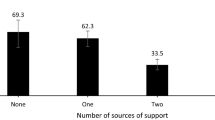Abstract
To improve outcomes for children and youth with serious emotional disturbance and their families, we need to create comprehensive and collaborative systems to promote systems change resulting in the development of coherent services built around their individual needs. These services should be family-centered, community-based, and appropriately funded. Unfortunately, barriers to understanding and operationalizing this level of collaboration persist, which challenges the aims of parents, practitioners, policy makers, and others to provide efficient and effective services to these students. I explore the seventh strategic target of the National Agenda for Achieving Better Results for Children and Youth with Serious Emotional Disturbance; provide examples of collaboration that relate to the National Agenda's other six strategic targets; and briefly discuss the present opportunities for and challenges to collaboration.
Similar content being viewed by others
REFERENCES
Bruner, C. (1991). Thinking collaboratively: Ten questions and answers to help policy makers improve children's services.Washington, DC: Education and Human Services Consortium, Institute for Educational Leadership.
Cuban, L. (1984).Transforming the frog into a prince: Effective schools research, policy, and practice at the district level.Harvard Educational Review,54,129–51.
Dwyer, K., & Osher, D. (2000).Safeguarding our children: An action guide.Washington, DC: U.S. Departments of Education and Justice, American Institutes for Research.
Goode, W. (1973).Explorations in social theory. New York: Oxford University Press.
Hodges, S., Nesman, T., & Hernandez, M. (1999). Promising practices: Building collaboration in systems of care. Systems of care: Promising Practices in Children's Mental Health, 1998 Series, Volume VI.Washington, DC: Center for Effective Collaboration and Practice, American Institutes for Research.
Huberman, M., Levinson, J., Havelock, R. G., & Cox, P. L. (1981).Interorganizational arrangements.Knowledge: Creation, Diffusion, Utilization,3,5–22.
Jewett, J., Conklin, N. F., Hagans, R., & Crohn, L. (1991). Integration of Education and Human Services Project: Conceptual synthesis and review of community-based integration activity.Portland, OR: Northwest Regional Educational Laboratory.
Johnson, H.W., McLaughlin, J. A., & Christensen, M. (1982). Interagency collaboration: Driving and restraining forces.Exceptional Children,48,395–399.
Joint Commission on the Mental Health of Children. (1973). Mental health: From infancy through adolescence: Report of the Joint Commission on the Mental Health of Children.New York: Harper & Row.
Kagan, S. L. (1991). United we stand: Collaboration for child care and early education services.New York: Teachers College Press.
McGuire, W. J. (1968). Attitude change and influence.Handbook of social psychology,Vol.IV.Newbury Park, CA: Sage Publications.
Melville, A. I., & Blank, M. J. (1993). Together we can: A guide for crafting a profamily system of education and human services.Washington, DC: U.S. Departments of Education and Health and Human Services.
Merton, R.K. (1957) Social theory and social structure.Glencoe, IL: Free Press.
Miles, M. M. (1978).On “networking. ”New York: Center for Policy Research.
Osher, D., & Hanley, T. V. (1996). Implications of the National Agenda to Improve Results for Children and Youth with or at Risk of Serious Emotional Disturbance. InR. J. Illback & C. M. Nelson(Eds.),Emerging school-based approaches for children with emotional and behavioral problems: Research and practice in service integration (pp.7–36).Binghamton, NY: The Haworth Press.
Osher, T., & Osher, D. (2002). The paradigm shift to true collaboration with families.Journal of Child and Family Studies,11,47–60.
Rothman, J. (1976). Promoting an innovation. InJ. Rothman (Ed.),Promoting change in organizations and communities (pp.22–57).New York: John Wiley.
Schulberg, H. C. (1973), From institutions to human services. In Y. Bakal (Ed.),Closing correctional institutions (pp. 39–48). Lexington, MA: Lexington Books.
U.S. Department of Education. (1994). National agenda for achieving better results for children and youth with serious emotional disturbance.Washington, DC: U.S. Department of Education.
Author information
Authors and Affiliations
Rights and permissions
About this article
Cite this article
Osher, D.M. Creating Comprehensive and Collaborative Systems. Journal of Child and Family Studies 11, 91–99 (2002). https://doi.org/10.1023/A:1014771612802
Issue Date:
DOI: https://doi.org/10.1023/A:1014771612802




